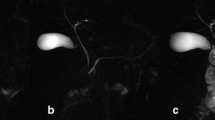Abstract
We propose the hypothesis that the enlargement of the common bile duct (CBD) or gallbladder (GB) that is occasionally demonstrated on magnetic resonance cholangiopancreatography (MRCP) after secretin stimulation is caused by pancreatobiliary reflux. Recently, occult pancreatobiliary reflux (OPR) has been demonstrated in patients without morphological pancreatobiliary maljunction (MPBM). The aim of this study was to evaluate the efficacy of secretin-stimulating MRCP (SMRCP) in the diagnosis of pancreatobiliary reflux. The study included 14 patients with MPBM and 32 patients with a normal pancreatobiliary junction. OPR was evaluated by bile collection and diagnosed in seven of the 32 patients. All the patients underwent SMRCP; the related findings were considered positive when enlargement of the CBD or GB was observed. Positive findings on SMRCP were observed in all MPBM patients. In the patients with normal pancreatobiliary junction, there was significant difference between the mean amylase levels in the patients with positive and negative SMRCP findings (mean, 4,755.7 and 29.7 IU/l). The sensitivity and specificity of SMRCP for diagnosing OPR was 85.7% and 68.0%, respectively. SMRCP provides a non invasive method for excluding PBR and can identify patients who could benefit from bile duct sampling to diagnose OPR.



Similar content being viewed by others
References
Matsumoto Y, Fujii H, Itakura J et al (2002) Recent advances in pancreaticobiliary maljunction. J Hepatobiliary Pancreat Surg 9:45–54
Tashiro S, Imaizumi T, Ohkawa H et al (2003) Pancreaticobiliary maljunction: retrospective and nationwide survey in Japan. J Hepatobiliary Pancreat Surg 10:345–351
Matsubara T, Sakurai Y, Sasayama Y et al (1996) K-ras point mutations in cancerous and noncancerous biliary epithelium in patients with pancreaticobiliary maljunction. Cancer 77(S8):1752–1757
Kaneko K, Ando H, Ito T et al (1996) Increased cell proliferation and transforming growth factor-alpha (TGF alpha) in the gall-bladder epithelium of patients with pancreaticobiliary maljunction. Pathol Int 46:253–260
Matsubara T, Funabiki T, Jinno O et al (1999) p53 gene mutations and overexpression of p53 product in cancerous and noncancerous biliary epithelium in patients with pancreaticobiliary maljunction. J Hepatobiliary Pancreat Surg 6:286–293
Sai JK, Ariyama J, Suyama M et al (2002) Occult regurgitation of pancreatic juice into the biliary tract: diagnosis with secretin injection magnetic resonance cholangiopancreatography. Gastrointest Endosc 56:929–932
Sai JK, Suyama M, Kubokawa Y et al (2003) Occult pancreatobiliary reflux in patients with a normal pancreaticobiliary junction. Gastrointest Endosc 57:364–368
Itoi T, Tsuchida A, Itokawa F et al (2005) Histologic and genetic analysis of the gallbladder in patients with occult pancreatobiliary reflux. Int J Mol Med 15:425–430
Hosoki T, Hasuike Y, Takeda Y et al (2004) Visualization of pancreaticobiliary reflux in anomalous pancreaticobiliary junction by secretin-stimulated dynamic magnetic resonance cholangiopancreatography. Acta Radiol 45:375–382
Bali MA, Sztantics A, Metens T et al (2005) Quantification of pancreatic exocrine function with secretin-enhanced magnetic resonance cholangiopancreatography: normal values and short-term effects of pancreatic duct drainage procedures in chronic pancreatitis. Initial results. Eur Radiol 15:2110–2121
Kimura K, Ohto M, Saisho H et al (1985) Association of gallbladder carcinoma and anomalous pancreatobiliary ductal union. Gastroenterol 89:1258–1265
Komi N, Kunitomo K, Tamura T et al (1984) Nationwide survey of cases of choledochal cyst: analysis of coexistant anomalies, complications and surgical treatment in 645 cases. Surg Gastroenterol 3:69–73
Matsubara T, Sakurai Y, Sasayama Y et al (1996) K-ras point mutations in cancerous and noncancerous biliary epithelium in patients with pancreaticobiliary maljunction. Cancer 77:1752–1757
Song HK, Kim MH, Lee SK et al (2003) Progressive bile duct and gallbladder dilation on MRCP after secretin stimulation: physiologic or pathologic finding? Gastrointest Endosc 58:165, author reply 165–166
Kanno N, LeSage G, Glaser S et al (2001) Regulation of cholangiocyte bicarbonate secretion. Am J Physiol Gastrointest Liver Physiol 281:612–625
Acknowledgements
We thank our departmental radiologists, T. Araki, A. Nambu, H. Nakajima, A. Ito, M. Hori, K. Ishigame, H. Sou, M. Nagata, K. Sano, and E. Jin, for collecting the MR data. We gratefully acknowledge the continuing assistance of the doctors from the First Department of Internal Medicine and the First Department of Surgery for their help with regard to bile collection.
Author information
Authors and Affiliations
Corresponding author
Rights and permissions
About this article
Cite this article
Motosugi, U., Ichikawa, T., Araki, T. et al. Secretin-stimulating MRCP in patients with pancreatobiliary maljunction and occult pancreatobiliary reflux: direct demonstration of pancreatobiliary reflux. Eur Radiol 17, 2262–2267 (2007). https://doi.org/10.1007/s00330-007-0640-z
Received:
Revised:
Accepted:
Published:
Issue Date:
DOI: https://doi.org/10.1007/s00330-007-0640-z




